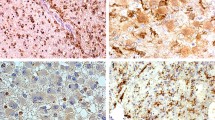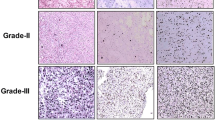Abstract
The proliferative potential of 39 pilocytic and 5 low grade astrocytomas was studied in relation to the Ki-67 activity as measured by the MIB-1 Labelings Index. The results were correlated to the biological behaviour of the tumor as measured by clinical and neuro-radiological (CT- or MRI-scans) follow-up of the patient. This study was undertaken to answer the question whether MIB-1 expression reflects differences in biological behaviour of these tumors, such as rapid progression of residual tumor or stable remaining tumor. MIB-1 LI values ranged from 0 to 19% in the group of pilocytic astrocytomas (mean 4,2%) and from 0 to 15% in the 5 low grade astrocytomas (mean 4,2%). All patients were operated and 23 of them had incomplete tumor resection as proven on postoperative neuro-imaging studies. Those 23 patients could be subdivided into two groups; one without progression of residual tumor during follow-up (n=12) and the other with tumor progression (n=11). mean MIB-1 LI in the group with ‘quiescent’ tumor tended to be lower than in the group with progressive tumor: 3,3% vs. 6,6%. Residual tumors which were negative for MIB-1 staining showed fewer progressions of residual tumor compared to those being positive for MIB-1 staining, however this difference was not significant (p=0, 15, Fisher exact test). Tumor samples of a second operation of the same patient had lower MIB-1 LI values than those of the samples taken at first operation. The proliferating potential seemed to be decreased after part of the tumor was resected. Pilocytic astrocytomas with a negative MIB-1 LI are unlikely to show progression of residual tumor after partial resection. MIB-1 staining might be an additional tool in determining the frequency and duration of follow-up and in making decisions regarding further treatment of a patient operated for a pilocytic astrocytoma with residual tumor.
Similar content being viewed by others
References
Coons SW, Johnson PC: Regional heterogeneity in the proliferation activity of human gliomas as measured by the Ki-67 labelling index. J Neuropathol Exp Neurol 52 no. 6: 609–618, 1993
Dirven CMF, Mooij JJA, Molenaar WM: The cerebellar pilocytic astrocytoma: A treatment protocol based upon analysis of 73 cases and a review of the literature. Child’s Nerv Syst 13: 17–23, 1997
Gerdes J, Schwab V, Lemke H, Stein H: Production of a mouse monoclonal antibody reactive with a human nuclear antigen associated with cell proliferation. Int J Cancer 31: 13–20, 1983
Gerdes J, Becker MHG, Key G, Cattoretti G: Immunohistological detection of tumour growth fraction (Ki-67 antigen) in formalin-fixed and routinely processed tissues. J Pathol 168: 85–86, 1992
Giangaspero F, Doglioni C, Rivano MT, Pileri S, Gerdes J, Stein H: Growth fraction in human brain tumors defined by the monoclonal antibody Ki-67. Acta Neuropathol 74(2): 179–182, 1987
Hara A, Hirayama H, Sakai N, Tamada H, Tanaka T, Mori H:Correlation between nucleolar organizer region staining and Ki-67 immunostaining in human gliomas. Surg Neurol 33(5): 320–324, 1990
Ito S, Hoshino T, Shibuya M, Prados MD, Edwards MSB, Davis RL: Proliferative characteristics of juvenile pilocytic astrocytomas determined by bromodeoxyuridine labeling. Neurosurgery 31: 413–419, 1992
Jaros E, Perry RH, Adam L, Kelly PJ, Crawford PJ, Kalbag RM, Mendelow AD, Sengupta RP, Pearson ADJ: Prognostic implications of p53 protein, epidermal growth factor receptor and Ki-67 labelling in brain tumours. Br J Cancer 66: 373–385, 1992
Louis DN, Edgerton S, Thor AD, Hedley-Whyte ET: Proliferating cell nuclear antigen and Ki-65 immunohistochemistry in brain tumors: A comparative study. Acta Neuropathol 81(6): 675–679, 1991
Maier H, Morimura T, Ofner D, Hallbrucker C, Kitz K, Budka H: Argyrophilic nucleolar organizer region proteins (Ag-NOR’s) in human brain tumors: Relations with grade of malignancy and proliferation indices. Acta Neuropathol 80: 156–162, 1990
Onda K, Davis RL, Shibuya M, Wilson CB, Hoshino T: Correlation between the bromodeoxyuridine labeling Index and the MIB-1 and Ki-67 proliferating cell indices in cerebral gliomas. Cancer 74: 1921–1926, 1994
Onda K, Davis RL, Wilson CB, Hoshino T: Regional differences in bromodeoxyuridine uptake, expression of Ki-67 protein, and nuclear organizer region counts in glioblastoma multiforme. Acta Neuropathol 87: 586–593, 1994
Ostertag CB, Volk B, Shibata T, Burger P, Kleihues P: The monoclonal antibody Ki-67 as a marker for proliferating cells in stereotactic biopsies of brain tumours. Acta Neurochir 89(3–4): 117–121, 1987
Shibata T, Burger PC, Kleihues P: Ki-67 immunoperoxidase stain as marker for the histological grading of nervous system tumours. Acta Neurochir Suppl (Wien) 43: 103–106, 1988
Tsanaclis AM, Robert F, Michand J, Brem S: The cycling pool of cells within human brain tumors. Can J Neurol Sci 18(1): 12–17, 1991
Wakimoto H, Aoyagi M, Nakayama T, Nagashima G, Yamamoto S, Tamaki M, Hirakawa K: Prognostic significance of Ki-67 labeling indices obtained using MIB-1monoclonal antibody in patients with supratentorial astrocytomas. Cancer 77: 373–380, 1996
Zuber P, Hamou MF, de Tribolet N: Identification of proliferating cells in human gliomas using the monoclonal antibody Ki-67. Neurosurgery 22 no. 2: 364–368, 1988
Author information
Authors and Affiliations
Rights and permissions
About this article
Cite this article
Dirven, C.M., Koudstaal, J., Mooij, J.J.A. et al. The proliferative potential of the pilocytic astrocytoma: The relation between MIB-1 labeling and clinical and neuro-radiological follow-up. J Neurooncol 37, 9–16 (1998). https://doi.org/10.1023/A:1005905009449
Issue Date:
DOI: https://doi.org/10.1023/A:1005905009449




